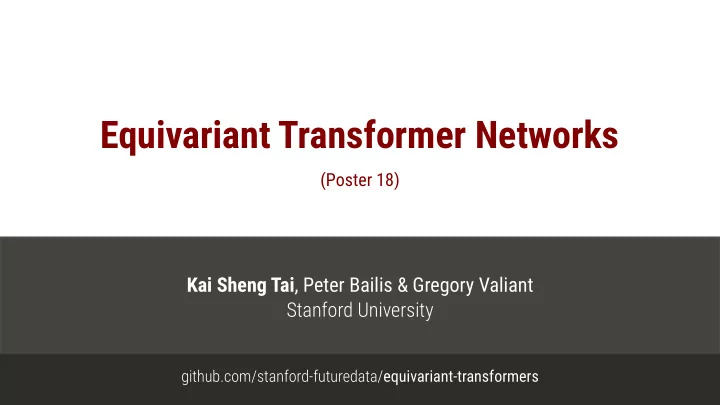

Equivariant Transformer Networks (Poster 18) Kai Sheng Tai , Peter Bailis & Gregory Valiant Stanford University github.com/stanford-futuredata/ equivariant-transformers
Goal: Transformation-invariant models ● How can we learn models that are invariant to certain input transformations? ● Relevant to many application domains: astronomical objects plankton micrographs traffic signs ● In this work, we explore alternatives to data augmentation ● How can we build invariances directly into network architectures? [Group Equivariant CNNs (Cohen+’16, Dieleman+’16), Harmonic Networks (Worrall+’17), etc.] ● Can we achieve invariance while reusing off-the-shelf architectures? [Spatial Transformer Networks (Jaderberg+’15)]
Equivariant Transformer Layers Standard 2 ET CNN ● An Equivariant Transformer (ET) is a differentiable image-to-image mapping ● Key property (“ local invariance ”): ⎼ all transformed versions of a base image are mapped to the same output image ● Requirement : ⎼ family of transformations forms a Lie group: transformations are invertible, differentiable wrt a real-valued parameter ⎼ includes many common families of transformations: translation, rotation, scaling, shear, perspective, etc.
Key ideas 1. Standard convolutional layers are translation-equivariant ⎼ i.e., input translated by 𝜄 → output translated by 𝜄
Key ideas 1. Standard convolutional layers are translation-equivariant ⎼ i.e., input translated by 𝜄 → output translated by 𝜄 2. Specialized coordinates turn smooth transformations into translation ⎼ Example (rotation): in polar coordinates, rotation appears as translation by angle 𝜄 Cartesian coordinates Polar coordinates ⎼ This can be generalized to other smooth transformations using canonical coordinate systems for Lie groups (Rubinstein+’91)
ETs are locally invariant by construction inverse transformation translation estimated canonical equivariant transformation coordinate CNN parameter representation ● Equivariance guarantees that an additional transformation of 𝜄 causes the estimated parameter to be increased by 𝜄 ● The output is therefore invariant to transformations of the input ● We implement transformation with differentiable grid resampling (Jaderberg+’15)
Compositions of ETs handle more complicated transformations ● Since ETs map images to images, they can be composed sequentially input x-shear aspect ratio x-perspective y-perspective
ETs improve generalization larger improvements when training data is limited
Takeaways Poster #18 kst@cs.stanford.edu ● Equivariant Transformers build transformation invariance into neural network architectures ● Main ideas: ⎼ Canonical coordinates let us tailor ET layers to specific transformation groups ⎼ Image-to-image interface lets us compose ETs to handle more complicated transformation groups Try it yourself! github.com/stanford-futuredata/ equivariant-transformers
Recommend
More recommend